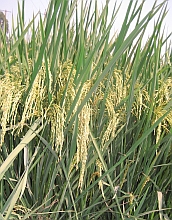News Release 07-025
Biologists Develop Large Gene Dataset for Rice Plant
Leads to Increased Understanding of Essential Food Crop

Plant biologists have reported a new understanding of how genes work in rice.
March 13, 2007
This material is available primarily for archival purposes. Telephone numbers or other contact information may be out of date; please see current contact information at media contacts.
Scientists have reported development of a large dataset of gene sequences in rice. The information will lead to an increased understanding of how genes work in rice, an essential food for much of the world's population.
Plant biologist Blake Meyers at the University of Delaware and colleagues report their results in the March 11 on-line issue of the journal Nature Biotechnology.
Using advanced gene sequencing technologies and high-powered computer-based approaches, Meyers and colleagues examined both normal gene expression (via messenger ribonucleic acids, or mRNAs) as well as small ribonucleic acids (small RNAs) in rice.
The analysis of rice was based on gene sequences representing nearly 47 million mRNA molecules and three million small RNAs, a larger dataset than has been reported for any other plant species.
Small RNAs are considered one of most important discoveries in biotechnology in the last 10 years. Because they are so much smaller than mRNAs, small RNAs went unnoticed for many years, or were considered biologically unimportant, said Meyers.
Small RNAs are now known to play an important role in gene regulation, he said, adding that deficiencies in small RNA production can have a profound effect on development.
"Small RNAs also have been associated with other important biological processes, such as responses to stress," Meyers said. "Many of small RNAs in rice have related sequences in the many important cereal crop plants, including maize and wheat."
Research on small RNAs "is a leading edge in plant biotechnology," said Machi Dilworth, Director of the National Science Foundation (NSF)'s Division of Biological Infrastructure, which along with the U.S. Department of Agriculture, funded the research. "This work will contribute to an understanding of the role of small RNAs in gene expression not only in rice, but in all plants."
-NSF-
Media Contacts
Cheryl Dybas, NSF, (703) 292-7734, email: cdybas@nsf.gov
The U.S. National Science Foundation propels the nation forward by advancing fundamental research in all fields of science and engineering. NSF supports research and people by providing facilities, instruments and funding to support their ingenuity and sustain the U.S. as a global leader in research and innovation. With a fiscal year 2023 budget of $9.5 billion, NSF funds reach all 50 states through grants to nearly 2,000 colleges, universities and institutions. Each year, NSF receives more than 40,000 competitive proposals and makes about 11,000 new awards. Those awards include support for cooperative research with industry, Arctic and Antarctic research and operations, and U.S. participation in international scientific efforts.
Connect with us online
NSF website: nsf.gov
NSF News: nsf.gov/news
For News Media: nsf.gov/news/newsroom
Statistics: nsf.gov/statistics/
Awards database: nsf.gov/awardsearch/
Follow us on social
Twitter: twitter.com/NSF
Facebook: facebook.com/US.NSF
Instagram: instagram.com/nsfgov
